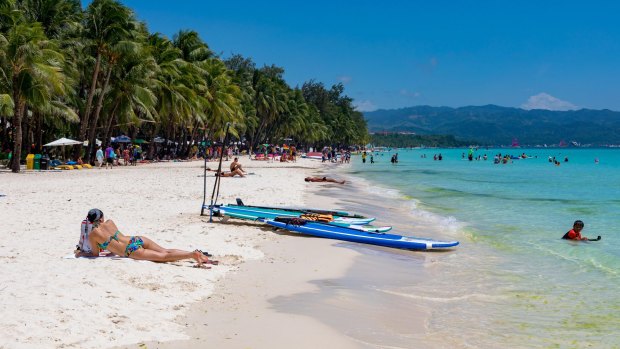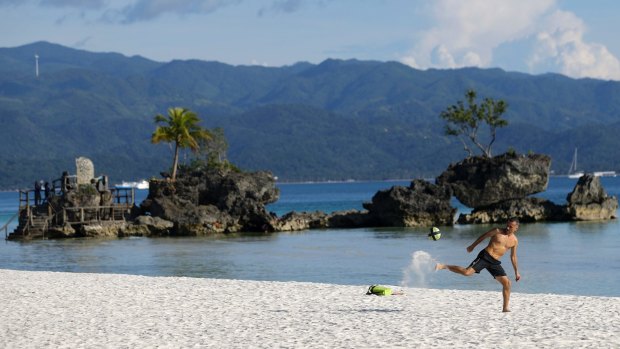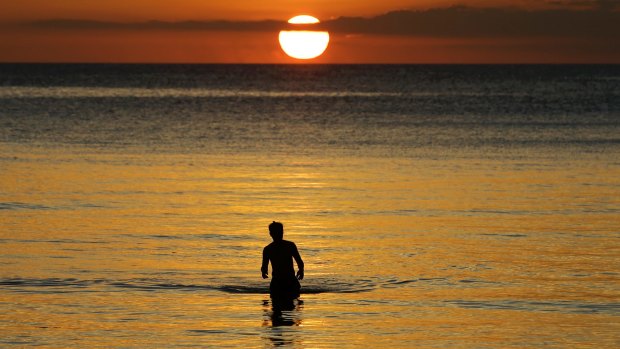This was published 5 years ago
Boracay, Philippines reopens to tourists with bans on beach parties, plastic bags and smoking
By Hugh Morris

Travel+Leisure magazine declared Boracay the best island in the world back in 2012, thanks largely to the powder soft sand of White Beach (pictured).Credit: Alamy
Visitors to a newly reopened Boracay will be subject to a set of stringent rules to avoid the Philippine island paradise from returning to the "cesspool" state that led to its closure earlier in the year.
After a six-month clean-up operation, the tiny outcrop in the Sulu Sea has reopened for a "dry run" of 10 days, during which only local tourists will be allowed entry while authorities assess the island's "rehabilitation". On October 26 Boracay will open officially to all nationalities.
As well as an overnight visitor cap of 19,000, new regulations to be imposed on travellers include a ban on smoking and drinking on White Beach and a temporary restriction on all watersports.

After a six-month clean-up operation, the tiny outcrop in the Sulu Sea has reopened for a "dry run" of 10 days.Credit: AP
What is Boracay and why was it shut?
The Philippines has experienced a surge in tourists in recent years. Just over one million went there in 1990 – last year it was 6.6m. And almost a third of those tourists - more than two million - visited Boracay, which measures just 3.98 square miles and has a resident population of just 30,000. That's all the more remarkable when you consider that the Philippines has 7,640 other islands to choose from, according to the most recent estimate from the country's National Mapping and Resource Information Authority.
A decade ago, Boracay certainly was worth visiting. The magazine Travel+Leisure declared it the best island in the world back in 2012, thanks largely to the powder soft sand of White Beach. But back in April President Rodrigo Duterte called it a "cesspool". His verdict came after a video showing sewage flowing directly into Boracay's blue waters went viral. The controversial leader castigated local authorities for permitting unchecked development and dispatched an emergency government taskforce to save the island from an ecological catastrophe. Inspectors found over 800 environmental violations. Figures showed that rubbish generated per person on Boracay was more than three times higher than in the capital, Manila.

As well as an overnight visitor cap of 19,000, new regulations to be imposed on travellers include a ban on smoking and drinking on White Beach.Credit: AP
Is the island ready to be reopened?
According to local authorities it is, but officials from the Boracay Inter-agency Task Force (IACT) have asked the public to "manage expectations" ahead of returning to the island.
Tourism secretary Benadette Romulo Puyat told CNN that the public needs to understand that returning the island to its optimal state will be done in phases and that the "full rehabilitation" will not be complete until next December.
Authorities have said that issues with the sewage infrastructure - which led to the "cesspool" description - have been resolved, with bacteria levels in the water on a par with international standards. There are, however, still road repairs taking place.
In September, president of the Tourism Congress of the Philippines Jose Clemente said "rehabilitation is just 50 per cent", adding: "If [tourists] insist on visiting, don't expect a fully restored Boracay as it is still a work in progress."
What new rules will be in place?
A cap of 19,000 overnight visitors will be in place, while tourists may be required to present their hotel bookings to authorities before entering the island. The hotel capacity on the island is being reduced from 12,000 rooms to as few as 6,000.
A number of other recommendations by the task force will also be adopted, including a ban on "LaBoracay" parties that used to attract as many as 70,000 tourists. Last year's LaBoracay party left 10,000kg of rubbish, authorities said. Casinos will also be banned, apparently scuppering plans for a $500million complex funded by Chinese firm Galaxy Entertainment.
Drinking, smoking and dining on White Beach will be prohibited, while there will be a temporary suspension of diving in surrounding waters as well as water activities such as banana boating and parasailing. The building of giant sand castles will also be regulated.
Souvenir shops and electric lights will be prohibited from the beachfront, and there will be a restriction on firework displays after 9pm. The hot-coal roasting of meats will be banned.
Single-use plastics will also be banned from the island, with any hotel, resort or restaurant caught breaching the policy three times to lose its licence. Visitors have been told to "bring your own straw", and that plastic bags will be prohibited.
Where should you go alternatively in the Philippines?
Our expert Trisha Andres suggests three alternatives to Boracay:
Coron
El Nido is often in the spotlight but neighbouring municipality Coron in Palawan has equally awe-inspiring white sand beaches and volcanic limestone cliffs that hunker over lagoons. The photos you see on postcards of darting cliffs encasing the Twin Lagoons are actually of Coron and not of El Nido.
This is a good base from where to island-hop around the Calamian Group of Islands' beautiful beaches, lakes and lagoons. Stop at Kayangan, the country's cleanest lake encircled by huge granite rock formations; Twin Lagoons, where access to the second lagoon is through a small crevice underneath a rock; Maquinit, one of the few saltwater hot springs in the world; snorkelling site Siete Pecados; and Coron Town. Stay at Club Paradise, an island-resort surrounded by limestone karst scenery and tropical jungle.
Cebu
This long and narrow island is at the heart of the Visayan Islands and plays a central role in the region's economy. It's no surprise then that it is easy to get to, with dozens of daily domestic flights from Manila and several flights from Asian hubs that fly directly into the capital, Cebu City. Just off the coast are a number of upscale, family-focused hotels. The beaches here are rather underwhelming, so best hire a boat to take you out to the islands in the Bohol Strait, where powder-white sand and coconut trees decorate the beaches. If you're feeling adventurous, travel four hours by car to the port of Maya, where small boats make the 10-minute journey to Malapascua Island, which abounds with beautiful sandy bays, including dazzlingly white Bounty Beach and, for divers, thresher sharks.
Siargao
The teardrop-shaped island is considered the country's best surf spot, but there's more to the island than world-famous surf breaks. If you're not a keen surfer, give the right-breaking reef wave Cloud 9 a miss and book an island-hopping excursion instead. Stops include Dako, a large island where coconut palms back a crescent of white sand on its southernmost tip; Guyam Island, a small uninhibited islet which you can have all to yourself for the day; and Naked Island, a stunning expanse of white sand that's devoid of any vegetation save for a few baby palm trees. Base yourself at Dedon Island (dedonisland.com), a private resort made up of nine Filipino-style villas decorated with covetable hand-woven rattan furniture.
The Telegraph, London
Sign up for the Traveller Deals newsletter
Get exclusive travel deals delivered straight to your inbox. Sign up now.